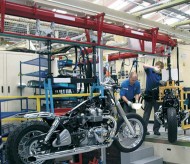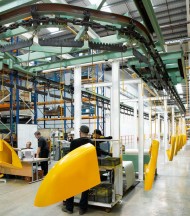 Floor space is at a premium whatever business you are running. So if you need to move products around safely whilst keeping your valuable floor area clear, an ideal solution is to use the typically redundant roof space in your facility. An automatic transportation system, in the form of an overhead conveyor, will fit neatly into this void.
Floor space is at a premium whatever business you are running. So if you need to move products around safely whilst keeping your valuable floor area clear, an ideal solution is to use the typically redundant roof space in your facility. An automatic transportation system, in the form of an overhead conveyor, will fit neatly into this void.
Choosing this option allows you to not only improve productivity, but also to reduce labour costs as there will be less (or no) manual handling of product as it moves around the factory. With fewer obstacles in the way, an overhead system can also be designed to use the most direct route, moving products ‘as the crow flies’. But there are many different ways of transporting goods overhead, so how do you decide which particular system would be best for you?
There are five main types of overhead conveyor: power chain or monorail; power and free; electrified monorail (EMS); a basic free conveyor or a towline system. Each one is manufactured using a modular construction and standard components in different configurations.
A typical overhead conveyor is mounted above with products hung from it. Power chain or monorail systems utilise a continuous chain running in or on a track. JCB has a heavy duty, drop forged power chain conveyor providing transport for a range of fabrications in its modern powder coating plant in the Heavy Products Division located in Uttoxeter.
An enclosed track, power only overhead conveyor is used for the assembly line of famous motorbikes, manufactured by Triumph Motorcycles at their Hinckley Works.
A power and free conveyor has a twin track arrangement where a powered chain is mounted above a free running trolley track. This design offers a great deal of flexibility, allowing products to be diverted for various processes and accumulated for buffer storage. This particular type of conveyor has been installed in the CMK (Treatments) plant in Oldbury, Birmingham, and using it has enabled the company to increase their production capacity by 20%.
Manual conveyors are designed around a track with trolleys that are pushed around by operators. These types of conveyor are ideal and cost effective for when throughputs are relatively low. Electrified monorail conveyors utilise individual motorised trolleys with an inbuilt motor controlled by a busbar coupled to the track.
A towline conveyor is an inverted overhead chain conveyor. These systems are either mounted on or in the floor and are used to move products either directly from the chain on a jig or they can be used as a pushing or pulling medium for automatically moving products on work trolleys through various processes.
Overhead conveyors are mainly sited in the following industries; manufacturing and assembly (including automotive), warehousing/logistics and surface finishing (wet paint and powder).
Striking the right balance
The first condition to consider when selecting an overhead conveyor is the type, dimensions (envelope) and weight of the goods that will be transported. This will establish the overall carrying capacity required and the size of conveyor needed to ensure that the load remains stable. A large but light product may need to be transported by a heavier duty system to optimise the stability of the moving load.
Process requirement is the next determining factor – where will the conveyor be located and what type of production facility is it? Will the machinery be subject to hostile environments that could be corrosive in a pre-treatment plant for example, or the extreme heat of a curing oven?
Understanding the throughput of the goods to be carried is a vital element in the decision process regarding the speed and pitch of the conveyor. In some cases, different procedures in the production process require the conveyor to travel at varying speeds or indeed have elements where part of the conveyor remains stationary for periods of time.
If fast and flexible operations over short distances are needed, then an EMS or electrified monorail would be the perfect option. These systems have individually controlled carriers which can transport at a rate of up to 120m/min and can carry various attachments from rotation devices to hoists. At the other end of the scale, a low throughput requirement is best for a manual conveyor system. Once the process and throughput requirements are established, a decision on the type of conveyor can be made.
It will now be necessary to consider the supporting structure for the system. A roof supported conveyor is ideal as it keeps the floor area completely clear. However, the roof may not be strong enough or sufficiently close to the system to bear its weight. In this instance, floor mounted steel work is installed to provide a supporting structure. An overhead track will self-support over three metres, so a combination of columns, spine beams and brackets can be used to give optimum support with the least encumbrance at ground level.
Calling in the experts right from the start of the decision process is a good way of avoiding possible problems as they understand the key issues that must be addressed. Using one of the industry’s specialist conveyor suppliers, such as Leicester based CI Logistics, gives you access to a wealth of knowledge and expertise.
Gary Bale is the company’s managing director, he comments, “We can provide a total project management service, designing, manufacturing and installing the entire conveyor and control mechanism or, at the other end of the scale, supply the conveyor only. Selecting a supply partner with a UK base means that leadtimes are kept to a minimum and we can react quickly when the goalposts change.
“The task of selecting the right overhead conveyor is not a simple one, but there are many advantages if you decide to use a transport system for your goods that runs not on the ground, but up in the air.”
CI Logistics
Tel: 0116 276 1691





Comments are closed.